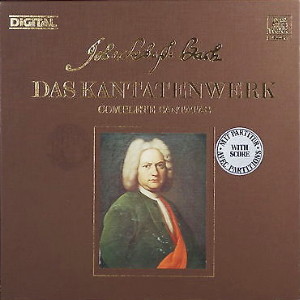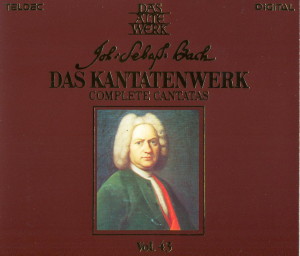 |
|
2 LPs
- 6.35836 EX - (p) 1989
|
 |
| 2 CDs -
8.35836 ZL - (p) 1989 |
|
| DAS KANTATENWERK - Volume 43 |
|
|
|
|
|
|
|
| Johann Sebastian
BACH (1685-1750) |
Kantate
"Es wartet alles auf dich", BWV 187
|
|
23' 05" |
|
|
Kantate
zum 7. Sonntag nach Trinitatis (Dominica
7 post Trinitatis)
|
|
|
|
|
Textdichter
unbekannt; 1. Psalm 104, 27-28; 4. Mattäus
6, 31-32; 7. Erfurt 1563
|
|
|
|
|
Solo:
Sopran, Alt, Baß - Chor; Oboe I, II,
Streicher; Continuo (Violoncello, Violone,
Organo)
|
|
|
|
|
Prima
Parte
|
|
|
|
|
- 1.
Concerto (Chor): "Es wartet alles auf
dich" |
7' 11" |
|
C1 |
|
- 2.
Recitativo (Basso): "Was Kreaturen hält
das grosse Rund der Welt" |
0' 55" |
|
C2 |
|
- 3.
Aria (Alto): "Du Herr, du krönst allein
das Jahre" |
4' 31" |
|
C3 |
|
Seconda
Parte
|
|
|
|
|
- 4.
Aria (Basso): "Darum sollt ihr nicht
sorgen" |
2' 45" |
|
C4 |
|
- 5.
Aria (Soprano): "Gott vesorget alles
Leben" |
4' 18" |
|
C5 |
|
- 6.
Recitativo (Soprano): "Halt' ich nur fest
an ihm mit kindlichem Vertrauen" |
1' 17" |
|
C6 |
|
- 7.
Choral: "Gott hat die Erde zugericht" |
2' 06" |
|
C7 |
|
|
|
|
|
Michael
Emmermann (Solist des Knabenchores
Hannover), Sopran
Paul Esswood, Alt
Max
van Egmond, Baß
Knabenchor Hannover |
Heinz Hennig, Leitung
Collegium Vocale Gent | Philippe
Herreweghe, Leitung
LEONHARDT-CONSORT mit
Originalinstrumenten
- Bruces Haynes, Ku Ebbinge, Oboen
- Marie Leonhardt, Alda
Stuurop, Marinette Troost, Antoinette van
den Hombergh, Lucy van Dael, Violinen
- Ruth Hesseling, Udbahava Wilson Meyer, Violen
- Wouter Möller, Richte van der Meer, Violoncelli
- Anthony Woodrow, Violone
- Gustav Leonhardt, Bob van Asperen, Organo
Gustav Leonhardt, Gesamtleitung
|
|
|
|
|
Luogo
e data di registrazione |
|
(luogo e data di
registrazione non indicati)
|
|
|
Registrazione: live
/ studio |
|
studio |
|
|
Producer |
|
Wolf Erichson
|
|
|
Prima Edizione LP |
|
Teldec "Das Alte
Werk" | 6.35836 EX | 2 LPs -
durata 42' 05" - 48' 16" | (p)
1989 | DIGITAL DMM
|
|
|
Edizione CD |
|
Teldec Classics |
LC 6706 | 8.35836 ZL | 2 CDs -
durata 42' 05" - 48' 16" | (p)
1989 | DDD |
|
|
Cover
|
|
Johann Sebastian
Nach, einige Jahre vor seiner
Ernennung zum Kantor in Leipzig.
Gemälde con JJ. Ihle (1720) Bach
Museum Eisenach.
|
|
|
Note |
|
In questo volume sono
presenti anche La Cantate BWV 185,
BWV 186 e BWV 188 a cura del
Concentus Musicus Wien diretto da
Nikolaus Harnoncourt.
|
|
|
|
|
INTRODUCTION
by Nele Anders
Bach also composed the
Cantata "Es wartet alles
auf dich" (BWV 187)
for the Seventh Sunday after
Trinity (of the year 1726,
however, so that this
cantata belongs to the third
annual cycle). The author of
the verse, which tells the
Gospel story of the feeding
of the five thousand, is
unknown. It was taken from a
collection of Prayers for
Sundays and Feast Days
printed in a second edition
in Rudolstadt in 1726. The
texts, which all have the
same structure - Old
Testament dictum -
recitative - aria - New
Testament dictum - aria -
recitative (and chorus) -
chorale - seem to have
enjoyed great popularity at
the time, with their
cheerful mood, the picture
they paint of a kind and
gracious God and their
intimate relationship to
nature. For Bach’s cousin
Johann Ludwig Bach, who held
the office of Kapellmeister
at the Meiningen court from
1711 onwards, also used them
for his cantatas. Johann
Sebastian Bach,
incidentally, performed
eighteen of these in 1726,
and incorporated them into
the third annual cycle of
his own cantatas. Unlike his
cousin, Johann Sebastian,
who loved the rhetoric form,
reduces the eight movements
of the original to seven
chiastically arranged
movements, the intellectual
centre of which is the New
Testament text in the fourth
movement. The musical
emphasis, though, lies on
the large-scale first choral
movement, which is
exceptionally characteristic
of Bachs mature cantata
style. The symphonically
conceived introduction,
which returns in ritornello
fashion either in larger
sections, or in small motifs
in between the
contrapuntally arranged
vocal sections, and which is
heard once more in full at
the end, already contains
the thematic material of all
the vocal movements that
follow. Bach's considerable
interest in questions of
theological exegesis led him
to take his bearings in the
word-bound structuring of
the movement from the old
psalmody: this is evident in
the fact that he does not
choose a soloistic form,
preferring to skilfully
combine canonic and
concertante elements in a
figured chorus. Nos. 2-6
also interpret the de
tempore text in a Lutheran
sense - "so take up the
psalter and you will have a
fine mirror, clear and
bright, that will show you
what Christianity is ..."
(Bible of 1534) - while No.
7, the hymnic chorale
”Singen wir aus
Herzensgrund" (Let us sing
with all our hearts) by Hans
Vogel (1563), gives a final
résumé of all the preceding
material. The plan of the
keys used supports this
concept: the beginning and
end of the cantata are in
the same key, G minor, while
the remaining movements
switch to other, related
keys (B flat major, E flat
major, C minor). Only the
vox Christi in the bass
aria, No. 4, underlines its
central position by
returning to G minor. Just
how much Bach valued this
particular cantata is shown
by his reuse of the first,
third, fourth and fifth
movements, according to the
so-called "parody method,”
in his Mass in G minor, BWV
235, which dates without so
much as a shadow of a doubt
from later than l726.
|
  |
|
|